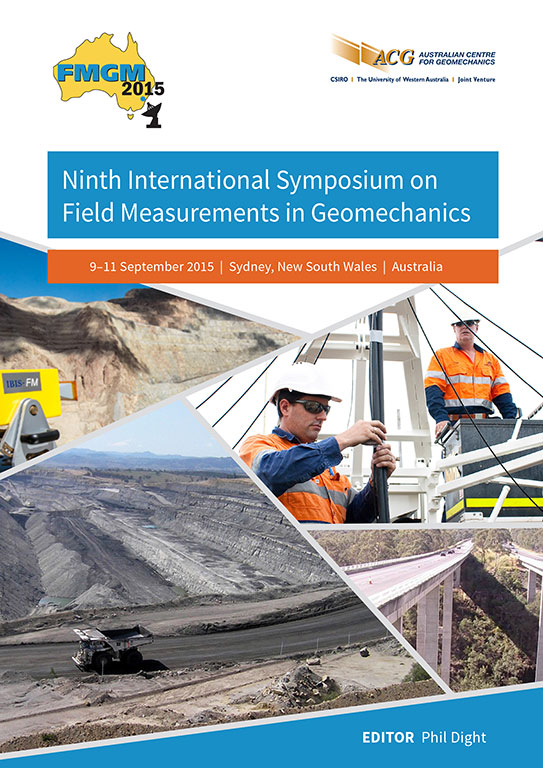Instrumented test shaft in soft ground

|
Authors: Thut, A; Rabaiotti, C; Wörsching, H Paper is not available for download Contact Us |
DOI https://doi.org/10.36487/ACG_rep/1508_28_Thut
Cite As:
Thut, A, Rabaiotti, C & Wörsching, H 2015, 'Instrumented test shaft in soft ground', in PM Dight (ed.), FMGM 2015: Proceedings of the Ninth Symposium on Field Measurements in Geomechanics, Australian Centre for Geomechanics, Perth, pp. 423-435, https://doi.org/10.36487/ACG_rep/1508_28_Thut
Abstract:
A large underground structure is planned under the existing main railway station of Lucerne (Switzerland) to expand the capacity of the station. An instrumented test shaft was built to study the proposed construction technique. The test shaft was 5.6 m wide and 13.6 m long consisting of reinforced diaphragm wall with a thickness of 80 cm and a depth of 24.0 m. Three levels of struts were planned to support of the excavation to a depth of 18.0 m. Prior to excavation of the test shaft jet grouting columns were built between 18.0 and 23.5 m to support the lower part of the wall and provide a seal against piping. The instrumentation used to monitor the test shaft included four TRIVEC systems (high precision measurements of the three displacement vectors), fixed to the reinforcement cage and imbedded in the concrete, inclinometers installed in the soil 1.5 m from the shaft, and strain gauges to measure forces on the struts during excavation.The effect of jet grouting at the base of the narrow excavation in soft soil led to high lateral pressures acting outward on the walls pushing the diaphragm wall against the soil outside of the shaft. The TRIVEC system indicated bending of the wall with maximum displacement of 130 mm at a depth of 12.0 m. Horizontal displacements of the same order of magnitude were observed in the upper soil layers. Increases in the measured forces in the struts during excavation showed that the buckling load on the struts would have been exceeded by the final level so additional struts were added. The results and interpretation of the measurements are presented and discussed in the paper.
References:
Amstad, C, Köppel, J, Kovári, K 1987, ‘TRIVEC-measurements in geotechnical engineering’, in S Sakurai (ed.), Proceedings of the 2nd International Symposium on Field Measurements in Geomechanics, AA Balkema, Brookfield, VT, pp. 17-32.
European Standard 2007, EN 1997-2:2007 Eurocode 7: Geotechnical design – Part 2: Ground investigation and testing, European Committee for Standardization (CEN), Brussels.
Frodl, H & Naterop, D 2007, ‘TRIVEC and Sliding micrometer: fully digital instruments for geotechnical displacement and deformation measurement’, in J DiMaggio & P Osborn (eds), Proceedings of the Seventh International Symposium on Field Measurements in Geomechanics, American Society of Civil Engineers, Reston, VA, pp. 1-12.
IG TiBLU 2013, ‘Geotechnische Vorversuche – Dokumentation der Ergebnisse’, IG TiBLU, report no. B 5018-016, 1222 p., internal report.
Kovári, K & Amstad, C 1982, ‘A new method of measuring deformations in diaphragm walls and piles’, Geotechnique, vol. 32, no. 4, pp. 402-406.
Peck, RB 1969, ‘Advantages and limitations of the observational method in applied soil mechanics’, Geotechnique, vol. 19, no. 2, pp. 171-187.
Rabaiotti, C, Malecki, C, Amstad, M & Puzrin, M 2015, Pre-stressing of soil and structures due to jet grouting, .
Schwager, MV 2013, ‘Development, analysis and applications of an inclinodeformeter device for earth pressure measurements’ PhD thesis, ETH Zürich.
© Copyright 2025, Australian Centre for Geomechanics (ACG), The University of Western Australia. All rights reserved.
View copyright/legal information
Please direct any queries or error reports to repository-acg@uwa.edu.au
View copyright/legal information
Please direct any queries or error reports to repository-acg@uwa.edu.au